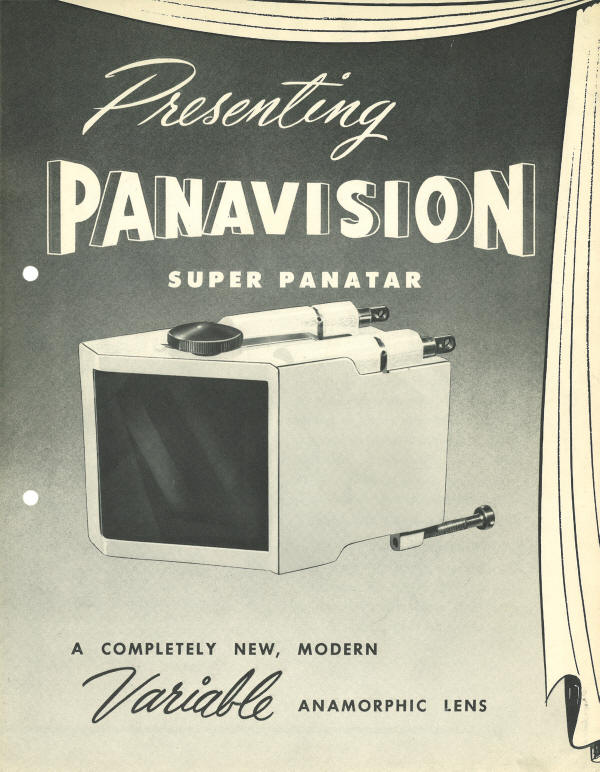The Super Panatar Variable Type Anamorphic Lens |
Read more at in70mm.com The 70mm Newsletter |
| Written by: ROBERT GOTTSCHALK, President, Panavision, Inc., Hollywood. Calif. MOTION PICTURE HERALD 3 JULY 54. Prepared for in70mm.com by Brian Guckian, Dublin, Ireland | Date: 20.12.2015 |
 THE ARRIVAL of the variable anamorphic attachments for projectors has been
welcomed by exhibitors. Its arrival means competition among the processes
now available. The exhibitor, therefore, has choice. There is no monopoly on
special attachments, or wide-screen processes, which marries the exhibitor
to any single method of screen presentation. Given that freedom of choice,
he has the opportunity to compare processes, and after a careful, studied
comparison, he has the opportunity to buy that attachment which suits him in
performance, price and availability. THE ARRIVAL of the variable anamorphic attachments for projectors has been
welcomed by exhibitors. Its arrival means competition among the processes
now available. The exhibitor, therefore, has choice. There is no monopoly on
special attachments, or wide-screen processes, which marries the exhibitor
to any single method of screen presentation. Given that freedom of choice,
he has the opportunity to compare processes, and after a careful, studied
comparison, he has the opportunity to buy that attachment which suits him in
performance, price and availability.• Go to PDF: Super Panatar Brochure • Go to The Importance of Panavision It is important to distinguish between the two basic types of anamorphic lenses. The first type to appear on the market was the cylindrical lens with an expansion power of two, to complement the camera lenses used in CinemaScope production. Naturally, it is absolutely essential that the projection lens "unsqueeze" the picture in the same degree that the taking lens "squeezed" it in photography. It will be seen therefore that since the optics of a "cylindrical" lens are designed for a fixed power, or magnification, of two, its use is restricted solely to the projection of CinemaScope film. There is disagreement among the studios as to which anamorphic ratio is the most desirable. This could be a most unhealthy situation for the exhibitor if it were not for the introduction of the variable prismatic anamorphic lens, which is the other basic lens type. The exhibitor who purchases Super Panatar variable anamorphic lenses can show the present CinemaScope product, and by simply turning a knob on the lens, show any other practicable anamorphic ratio which might come out of Hollywood. I feel that a word or two about comparison tests should be said at this time. Comparison tests conducted in an unscientific manner can be extremely misleading. Experience has shown that in order to conduct a fair comparison test it is imperative that the following conditions exist:
The writer has been present at many comparison tests and has found few to be
conducted scientifically. I recall one in particular where two different
makes of cylindrical lenses were compared. One was rated as having a much
greater light transmission than the other. Knowing this to be an optical
impossibility, I objected to the findings, even though the Super Panatar was
not involved. A second test with more rigid control indicated equal
transmission. |
More in 70mm reading: PDF: Panavision Super Panatar Brochure Panavison Large Format Motion Picture Systems The Importance of Panavision Super Panavision 70 Ultra Panavision 70 Ultra Panavision 70 Lens Internet link: "The Motion Picture Projectionist" |
 • Go to The Super Panatar Variable Type Anamorphic Lens |
|
| Go: back - top - back issues - news index Updated 22-01-25 |
